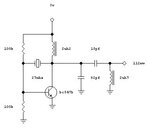neazoi
Advanced Member level 6
I have build and tested the attached circuit (image), from the PDF file which claims to be a near 100% efficient class-e crystal oscillator. However the efficiency I measure seems very bad.
First of all, shall I measure it on 50R or on 1Meg?
I am confused about my measurements on the scope, with VPP and with the its FFT, I may be doing something wrong.
First of all, shall I measure it on 50R or on 1Meg?
I am confused about my measurements on the scope, with VPP and with the its FFT, I may be doing something wrong.
